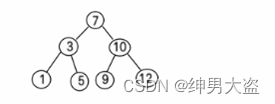二叉排序树
1、先看一个需求
给你一个数列 (7, 3, 10, 12, 5, 1, 9),要求能够高效的完成对数据的查询和添加。
1.1、解决方案分析
使用数组
数组未排序, 优点:直接在数组尾添加,速度快。 缺点:查找速度慢. [示意图]
数组排序,优点:可以使用二分查找,查找速度快,缺点:为了保证数组有序,在添加新数据时,找到插入位置后,后面的数据需整体移动,速度慢。[示意图]
使用链式存储-链表
不管链表是否有序,查找速度都慢,添加数据速度比数组快,不需要数据整体移动。[示意图]

使用二叉排序树
2、二叉排序树介绍
二叉排序树:BST: (Binary Sort(Search) Tree), 对于二叉排序树的任何一个非叶子节点,要求左子节点的值比当前节点的值小,右子节点的值比当前节点的值大。
特别说明:如果有相同的值,可以将该节点放在左子节点或右子节点
比如针对前面的数据 (7, 3, 10, 12, 5, 1, 9) ,对应的二叉排序树为:

3、二叉排序树创建和遍历
一个数组创建成对应的二叉排序树,并使用中序遍历二叉排序树,比如: 数组为 Array(7, 3, 10, 12, 5, 1, 9) , 创建成对应的二叉排序树为 :

3.1、代码实现
package com.qf.treesort;
import java.util.Map;
public class BinarySortTreeDemo {
public static void main(String[] args) {
BinarySortTree binarySortTree=new BinarySortTree();
binarySortTree.add(new Node(10));
binarySortTree.add(new Node(12));
binarySortTree.add(new Node(8));
binarySortTree.add(new Node(9));
binarySortTree.add(new Node(7));
binarySortTree.add(new Node(6));
binarySortTree.midOrder();
}
}
class BinarySortTree{
public Node root;
public void add(Node node){
if (root==null){
root=node;
}else{
root.add(node);
}
}
public void midOrder(){
if (root==null){
System.out.println("树为空~~~");
}else{
root.midOrder();
}
}
}
class Node{
public int value;
public Node left;
public Node right;
public Node(int value){
this.value=value;
}
@Override
public String toString() {
return "Node{" +
"value=" + value +
'}';
}
public void add(Node node){
if (this==null){
return;
}
if (this.value>node.value){
if (this.left==null){
this.left=node;
}else{
this.left.add(node);
}
}else{
if (this.right==null){
this.right=node;
}else{
this.right.add(node);
}
}
}
public void midOrder(){
if (this.left!=null){
this.left.midOrder();
}
System.out.println(this);
if (this.right!=null){
this.right.midOrder();
}
}
}





· Obsidian + DeepSeek:免费 AI 助力你的知识管理,让你的笔记飞起来!
· 分享4款.NET开源、免费、实用的商城系统
· 解决跨域问题的这6种方案,真香!
· 一套基于 Material Design 规范实现的 Blazor 和 Razor 通用组件库
· 5. Nginx 负载均衡配置案例(附有详细截图说明++)